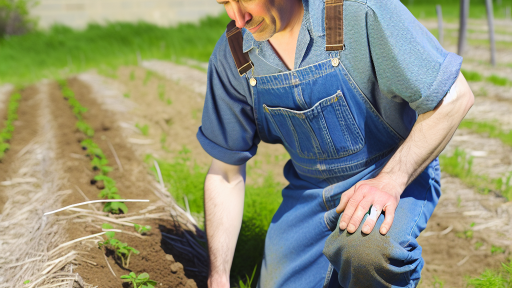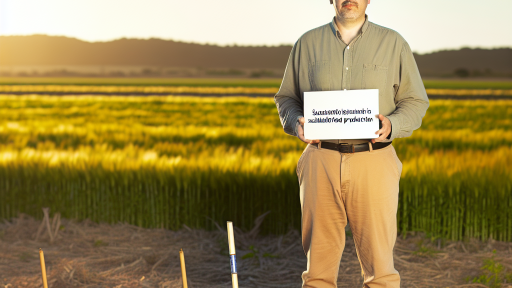Introduction
Crop rotation for sustainable soil health is the agricultural practice of growing different crops in the same area sequentially.
This method optimizes the use of soil nutrients, controls pests, and reduces the risk of disease.
Overview of its historical significance in agriculture
Historically, farmers have relied on crop rotation for centuries.
Ancient civilizations recognized its benefits, promoting soil fertility and productivity.
This practice helped ensure sustainable yields in various geographic regions.
Importance of sustainable soil health in modern farming practices
Sustainable soil health is fundamental in modern farming.
Healthy soil fosters plant growth, supports biodiversity, and retains moisture.
With increasing environmental concerns, sustainable practices become essential for long-term agricultural success.
Purpose of the blog post
This blog post aims to explore the numerous benefits of crop rotation for sustainable soil health.
Understanding these advantages can help farmers make informed decisions.
By adopting crop rotation, farmers protect soil health and improve crop productivity.
Through this exploration, we will delve into how crop rotation enhances soil nutrient cycling, minimizes erosion, and disrupts pest life cycles.
By improving soil structure and fertility, this practice leads to healthier crops and more sustainable farming systems.
Basically, the historical significance and modern importance of crop rotation demonstrate its role in supporting sustainable agriculture.
As we face challenges like climate change and population growth, implementing crop rotation can help meet these challenges effectively.
The Concept of Soil Health
Definition of Soil Health and Its Components
Soil health refers to the ability of soil to function effectively within natural or managed ecosystems.
A healthy soil sustains plants, animals, and humans.
It supports crop production, maintains water quality, and boosts biodiversity.
Soil health encompasses three primary components:
- Biological Properties: This includes the diversity and activity of organisms within the soil.
Microorganisms, earthworms, and other organisms contribute to nutrient cycling and organic matter decomposition. - Chemical Properties: Soil chemistry involves nutrient availability, pH levels, and the presence of toxic elements.
These factors determine a soil’s fertility and its ability to sustain crops. - Physical Properties: Soil texture, structure, and density all fall under this category.
These properties impact water retention, aeration, and root penetration, which are vital for plant health.
Importance of Soil Health for Crop Production
Soil health plays a pivotal role in crop production for several reasons:
- Increased Yield: Healthy soil promotes robust crop growth.
Proper balance and diversity of nutrients contribute to higher yields. - Enhanced Resilience: Healthy soils are more resistant to pests and diseases.
This resilience reduces the need for pesticides, which can harm the environment. - Improved Nutrient Cycling: Well-functioning soils naturally recycle nutrients.
Consequently, plants access essential minerals and minerals more efficiently. - Water Management: Healthy soils retain moisture better.
This characteristic is crucial during dry spells and can reduce irrigation needs. - Sustainability: Practices that promote soil health lead to long-term sustainability.
Healthy soils can support ongoing agricultural production without depleting resources.
Overview of Common Challenges Facing Soil Health Today
Despite its importance, several challenges threaten soil health worldwide:
- Soil Erosion: Wind and water erosion strip away topsoil, reducing soil fertility.
Erosion disrupts the ecosystem and diminishes land productivity. - Nutrient Depletion: Continuous cropping without replenishment leads to nutrient depletion.
This lack of nutrients can decrease crop yields over time. - Soil Compaction: Machinery-heavy agriculture often leads to soil compaction.
Compacted soils hinder root growth and water infiltration. - Pollution: Chemical runoff from fertilizers and pesticides contaminates soil.
Toxic substances can affect plant growth and harm beneficial soil organisms. - Climate Change: Climate variations impact soil moisture and temperatures.
These fluctuations can alter microbial activity and soil structure.
Confronting these challenges requires proactive measures and sustainable practices.
Cultivating soil health is essential for productive and resilient agricultural systems.
Key Benefits of Crop Rotation
Nutrient Management
Crop rotation provides vital benefits for nutrient management in agricultural practices.
How Different Crops Affect Soil Nutrients
Every crop has unique nutritional requirements and capabilities.
For instance, legumes like peas and beans fix nitrogen in the soil.
This process enriches the soil with essential nutrients, particularly nitrogen, which many plants require for growth.
Conversely, deep-rooted crops, like corn, can access nutrients locked deeper in the soil.
This ability allows them to utilize resources that shallow-rooted plants cannot reach.
Transform Your Agribusiness
Unlock your farm's potential with expert advice tailored to your needs. Get actionable steps that drive real results.
Get StartedBy rotating crops, farmers can optimize nutrient availability through various means.
Different plants contribute and consume different nutrients.
This diversity can prevent imbalances that lead to nutrient depletion.
Preventing Nutrient Depletion
Continuous planting of the same crop depletes specific nutrients.
For example, constant corn planting drains nitrogen from the soil.
Crop rotation interrupts this cycle, allowing time for soil nutrients to replenish.
Farmers can select crops that complement each other nutrient-wise.
A diverse planting schedule ensures better overall nutrient retention within the soil.
This approach minimizes the need for synthetic fertilizers, enhancing sustainability.
Pest and Disease Control
Crop rotation significantly contributes to effective pest and disease management.
Disruption of Pest Life Cycles
Many pests are specific to one type of crop.
By rotating crops, farmers disrupt the life cycles of these pests.
For example, pests that thrive on corn may struggle to survive when beans are planted instead.
This disruption reduces the overall pest population, limiting potential damage to crops.
Fewer pests mean healthier plants and possibly higher yields.
Reduced Reliance on Chemical Pesticides
With effective crop rotation, farmers rely less on chemical pesticides.
This practice promotes a more natural pest control method.
By decreasing the use of chemicals, farmers enhance environmental health.
Healthy ecosystems support various beneficial insects and wildlife.
Furthermore, reduced chemicals can lead to improved soil health over time.
Chemical residues can negatively impact soil microbes vital for a healthy ecosystem.
Improved Soil Structure and Fertility
Crop rotation plays a crucial role in enhancing soil structure and promoting fertility.
Role of Cover Crops in Enhancing Soil Structure
Farmers often use cover crops within their rotation plans.
These plants protect the soil during off-seasons.
Cover crops like clover or vetch improve soil structure.
They create a network of roots that holds soil together.
Such root systems prevent erosion and promote soil aeration.
Well-aerated soil allows water to penetrate effectively, improving moisture retention.
Increase in Organic Matter from Varied Root Systems
Different crops contribute varied root systems to the soil.
These systems increase organic matter, enhancing soil fertility.
As roots die and decompose, they add organic matter.
Enhanced organic matter improves soil texture and retains nutrients.
This process fosters a more biodiverse soil ecosystem.
Fungi, bacteria, and other organisms thrive in healthy, organic-rich soil.
Crop rotation is beneficial for farmers of all scales.
Adopting these practices encourages long-term sustainability.
Farmers can achieve healthier crops, reduce costs, and protect the environment with responsible crop management.
In a world increasingly affected by climate change and population growth, these strategies become more critical.
In short, the key benefits of crop rotation extend far beyond simple yield increases.
Effective nutrient management ensures that soils remain fertile and productive over time.
Pests and diseases find it much harder to establish when farmers rotate their crops strategically.
Lastly, improved soil structure and organic matter fortify ecosystems crucial to agriculture.
Implementing crop rotation in farming systems enhances plant health and promotes a more vibrant ecosystem.
As we strive for sustainable agriculture, embracing crop rotation emerges as a compelling solution.
Read: 8 Sustainable Farming Hacks You Need to Know Now
Different Crop Rotation Techniques
Sequential Cropping
Definition and Examples
Sequential cropping involves planting different crops in the same field in a specified sequence.
This method maximizes the use of land.
Farmers often choose crops that have different root depths or structures.
For instance, they might follow corn with soybeans.
Alternatively, a farmer may plant wheat after a legume crop.
These choices create biodiversity in the field.
Showcase Your Farming Business
Publish your professional farming services profile on our blog for a one-time fee of $200 and reach a dedicated audience of farmers and agribusiness owners.
Publish Your ProfileBenefits and Considerations
Sequential cropping offers numerous advantages for soil health.
- Enhances Nutrient Utilization: Different crops have varying nutrient needs.
This rotation reduces nutrient depletion. - Increases Soil Organic Matter: Rotating crops adds diverse residues to the soil, enhancing organic content.
- Reduces Pest and Disease Pressure: Sequentially planting breaks life cycles of pests and diseases.
- Improves Soil Structure: Different root systems aerate the soil differently, benefiting its structure.
- Boosts Crop Yields: Healthy soil leads to higher yields over time, maximizing farm productivity.
Farmers must consider local climates and soil types when planning crop sequences.
Crop selection should focus on complementary characteristics.
Proper planning can lead to sustainable agricultural practices.
Understanding the local ecosystem is crucial.
Intercropping
Explanation of the Method
Intercropping involves growing two or more crops simultaneously on the same land.
This practice enhances biodiversity in agricultural systems.
Crops are chosen based on their growth habits and nutrient needs.
For example, growing corn alongside beans is a common strategy.
The taller corn provides shade, while beans fix nitrogen in the soil.
Benefits for Soil Health
Intercropping significantly benefits soil health through various mechanisms.
- Improves Soil Fertility: Nitrogen-fixing legumes enrich the soil, benefiting subsequent crops.
- Promotes Biodiversity: Growing multiple crops leads to a more resilient ecosystem.
- Enhances Pest Control: Diverse plant species attract beneficial insects, reducing pest populations.
- Reduces Soil Erosion: Different root structures bind the soil, minimizing erosion risks.
- Increases Water Efficiency: Varied root systems optimize water absorption from different soil layers.
Farmers applying intercropping need to carefully consider spacing and compatibility.
Soil health relies on finding the right combinations of crops.
Attention to timing can also enhance benefits.
Proper intercropping enhances overall resilience within farming systems.
Both sequential cropping and intercropping strategies play crucial roles in maintaining sustainable soil health.
Each method offers unique benefits that promote biodiversity and enhance soil quality.
Understanding these techniques informs better agricultural practices.
Farmers that implement these strategies can support soil health effectively, ensuring sustainable productivity for generations.
Read: Polyculture Farming: Diversity in Action

Scientific Evidence Supporting Crop Rotation
Crop rotation has long been recognized as a cornerstone of sustainable agriculture.
Various scientific studies have demonstrated its remarkable benefits.
These studies often focus on yield improvements, soil health, and long-term sustainability.
Studies Showcasing Improved Yields and Soil Health
Many researchers have focused on how crop rotation enhances agricultural productivity.
Here are some key findings from notable studies:
- Increased Yield: A USDA study found that rotating corn with soybean can lead to a 10-15% increase in corn yield.
- Soil Nutrient Improvement: Research indicates rotating legumes with grains boosts nitrogen levels, benefiting subsequent crops.
- Reduced Pest Pressure: A study in Canada showed that crop rotation decreases pest populations compared to monoculture systems.
- Disease Reduction: The University of California found rotating crops reduced soil-borne diseases by 30-50%.
- Higher Organic Matter: Research indicates that diverse crop rotations promote greater organic matter in soils.
These studies showcase that implementing varied crop rotations leads to substantial improvements in both yields and soil health.
Farmers who adopt these practices notice enhanced crop performance and a healthier soil ecosystem.
Long-Term Benefits Observed in Various Climates and Soil Types
Crops grown in rotation demonstrate advantages across different climates and soil types.
Many long-term studies provide valuable insights into these benefits:
- Adaptability: Research by Ohio State University found that crop rotation benefits various climates, including arid and tropical regions.
- Soil Structure Improvement: Studies demonstrate that crop rotation positively impacts soil structure, making it more resilient.
- Enhanced Water Retention: A Kansas State University study showed improved water retention in rotated soils compared to monoculture.
- Climate Resilience: Crop rotation allows better adaptation to climate variability, enhancing agronomic stability.
- Reduced Soil Erosion: Researchers from the University of Georgia noted that rotation systems significantly reduce soil erosion risks.
The findings from long-term studies in various climates and soil types illustrate that crop rotation delivers robust, versatile benefits.
Farmers experience increased resilience and productivity, regardless of their initial soil or climate conditions.
Case Studies of Successful Crop Rotation Practices From Around the World
Beyond theoretical advantages, numerous case studies document successful crop rotation practices globally.
These examples highlight practical applications and outcomes:
- North America: Farmers in Iowa reported consistent corn and soybean rotations, leading to remarkable yield increases and reduced nitrogen costs.
- Australia: Wheat growers practicing multi-crop rotations, including legumes, reported enhanced soil fertility and reduced reliance on fertilizers.
- Europe: In the Netherlands, a mixed rotation of cereals and root crops helped increase biodiversity and stabilized yields.
- Asia: Indian farmers adopting diversified crop rotations, including pulses, demonstrated significant improvements in food security and income.
- Latin America: In Brazil, planting a mix of soybeans and cover crops promoted sustainable practices that enhanced soil health.
These case studies reveal successful implementations of crop rotation across various regions.
Each example reflects the adaptability and effectiveness of these systems in improving agricultural practices.
In essence, the scientific evidence supporting crop rotation highlights its numerous advantages.
From improved yields and enhanced soil health to successful case studies globally, crop rotation stands out.
Implementing crop rotation can help create a sustainable agricultural framework for future generations.
Read: Organic Farming: Biodiversity’s Best Friend
Implementation Challenges
Knowledge and Skill Requirements for Farmers
Implementing crop rotation effectively requires specific knowledge and skills.
Farmers need to understand the benefits and practices involved in crop rotation.
Here are some critical knowledge areas:
- Crop selection: Farmers must know which crops complement each other.
- Nutrient management: Understanding how different crops affect soil fertility is vital.
- Pest and disease management: Recognizing how rotation can disrupt pest cycles is crucial.
- Soil health indicators: Farmers should be able to assess soil health effectively.
- Weather patterns: Knowledge of local climate patterns can guide planting schedules.
Farmers may lack access to educational resources that address these skill requirements.
Many farmers operate in remote areas with minimal access to modern agricultural training.
Additionally, they may not be aware of the latest research on crop rotation methods.
To overcome these knowledge gaps, workshops and farming cooperatives can play key roles.
Moreover, mentorship programs can pair novice farmers with experienced practitioners.
Such collaborations can foster learning.
Policymakers should promote initiatives that enhance skill development among farmers.
Investment in educational resources will empower farmers to adopt sustainable practices.
Economic Considerations and Market Access
The economic landscape significantly influences farmers’ decisions regarding crop rotation.
Several economic factors can create barriers:
- Initial investments: Transitioning to crop rotation may incur costs for farmers.
- Market demand: Farmers must ensure that rotated crops have a viable market.
- Subsidies: Many farmers rely on government assistance for crop production.
- Profit margins: Farmers often prioritize high-yield crops over sustainability.
- Price volatility: Fluctuating crop prices can deter investment in new practices.
Farmers need assurance that they will sell rotated crops profitably.
Therefore, connecting farmers with local markets becomes essential.
Initiatives can help build demand for diverse crops.
This support can come through farmer’s markets, cooperatives, and community-supported agriculture (CSA) programs.
Moreover, financial incentives can facilitate the transition.
Policymakers should consider providing tax breaks or subsidies for sustainable practices.
Access to low-interest loans could also encourage farmers to adopt crop rotation.
These measures would mitigate the economic risks associated with transitioning from traditional methods.
Overcoming Cultural Resistance to Changing Traditional Practices
Cultural factors can pose significant challenges to implementing crop rotation.
Many farmers have relied on traditional farming methods for generations.
Such practices may shape their identities and community structures.
Therefore, here are crucial points to consider:
- Tradition versus innovation: Farmers may resist changes due to deep-rooted traditions.
- Community perception: A farmer’s choices can influence their standing within the community.
- Fear of failure: Concern about the effectiveness of new practices holds farmers back.
- Lack of peer support: Farmers often rely on peers for advice and validation.
- Cultural narratives: Success stories of traditional farming may overshadow modern practices.
To engage farmers, it is critical to share success stories of crop rotation.
Those who benefit from adopting sustainable practices can serve as role models.
Demonstration farms can showcase the impacts of crop rotation on soil health and yield.
Community engagement plays a pivotal role in overcoming resistance.
Workshops and community discussions can facilitate knowledge sharing and foster acceptance.
Local agricultural groups can create forums for dialogue around the benefits of crop rotation.
Involving local leaders in promoting sustainable practices can also help.
When respected individuals in the community advocate for crop rotation, farmers may feel more inclined to adopt these methods.
Outreach efforts should emphasize on both short-term gains and long-term benefits.
Therefore, successful implementation of crop rotation hinges on addressing these challenges.
Investing in knowledge and skills, navigating economic considerations, and overcoming cultural resistance is essential.
Through collaborative efforts, the agricultural community can move toward sustainable soil health practices.
Sustainable agriculture not only preserves soil quality but also ensures food security for future generations.
Read: Eco-Farms: Boosting Biodiversity Easily
Future of Crop Rotation in Sustainable Agriculture
Integration with Modern Agricultural Technologies
Modern agricultural technologies are transforming traditional farming methods.
Innovations enhance the effectiveness of crop rotation practices.
These technologies consist of precision agriculture, data analytics, and remote sensing.
- Precision Agriculture: This technique allows farmers to tailor their practices.
They can monitor soil health, moisture levels, and nutrient availability.
Precision technologies enable the application of fertilizers and water more efficiently.
This leads to improved crop yield and minimizes waste. - Data Analytics: Farmers can analyze field data to make informed decisions.
By integrating crop rotation schedules with crop performance data, they can identify optimal planting sequences.
This helps in maximizing productivity while maintaining soil health. - Remote Sensing: Drones and satellite imagery provide valuable insights into crop health.
These tools monitor changes in vegetation, pests, and diseases.
Farmers can adjust their strategies quickly, promoting better crop rotation outcomes.
Integrating these technologies can also streamline the application process.
Farmers can save time and resources while ensuring their methods remain sustainable.
Role of Research and Extension Services
Research and extension services play a significant role in sustainable agriculture.
They disseminate knowledge and breakthroughs in crop rotation practices.
Universities and agricultural institutions drive research and innovation.
- Research Initiatives: Institutions conduct studies to understand the benefits of crop rotation.
They evaluate its impact on soil structure, fertility, and productivity.
This research offers evidence-based guidelines for farmers. - Extension Services: These services provide crucial support to farmers.
They offer training and consultations on best practices.
Extension agents work closely with local farmers to address specific challenges in crop rotation. - Collaboration with Farmers: Engaging farmers in the research process fosters innovation.
Farmers can share their experiences and insights.
This feedback helps shape research initiatives that address real-world problems.
As these services evolve, they will continue promoting sustainable practices.
Increasing outreach and education will lead to better adoption of crop rotation.
Promoting Awareness and Education on Sustainable Practices
Raising awareness about crop rotation is essential for sustainable agriculture.
Education initiatives can enhance farmers’ knowledge and skills.
Comprehensive training programs can help shift perceptions about crop rotation.
- Workshops and Seminars: These events provide a platform for farmers to learn.
Experts can demonstrate the benefits of crop rotation through practical experiences.
Farmers can ask questions and share their challenges. - Online Resources: Digital platforms can disseminate information widely.
Online courses, webinars, and videos can show effective crop rotation strategies.
Farmers across various regions can access knowledge without geographical limitations. - Community Engagement: Local groups can collaborate to share successful crop rotation stories.
Networking helps build a supportive community.
Peer-to-peer learning fosters a culture of sharing knowledge and skills. - School Programs: Introducing agriculture education in schools can build a solid foundation.
Teaching students about sustainable practices creates future advocates for agriculture.
Young minds can carry forward the knowledge and values learned.
By promoting awareness and education, the farming community can embrace sustainable practices.
Informed farmers are more likely to adopt crop rotation in their operations.
The future of crop rotation in sustainable agriculture looks promising.
Integrating modern technologies with traditional practices enhances productivity.
Research and extension services will continue shaping farming approaches.
As awareness and education on sustainable practices grow, more farmers will embrace crop rotation.
This will ensure healthier soils and sustainable agricultural practices for future generations.
Conclusion
Recap of the Key Points Discussed
Crop rotation significantly enhances sustainable soil health.
It prevents soil erosion and improves fertility.
Different crops contribute unique nutrients to the soil.
Diverse root systems promote better soil structure.
Furthermore, crop rotation disrupts pest and disease cycles.
These methods decrease dependence on chemical fertilizers and pesticides.
The practice also increases biodiversity in agricultural systems.
Call to Action for Farmers and Agricultural Stakeholders
Farmers and agricultural stakeholders must prioritize crop rotation now.
Embrace sustainable practices that enhance soil health.
Start by planning crop rotations for the upcoming seasons.
Share successful strategies within your community.
Collaborate with agronomists to tailor rotations suited to specific soil types.
Consider joining cooperatives for knowledge sharing and support.
Vision for a Sustainable Agricultural Future Through Crop Rotation
Imagine a future where agriculture thrives in harmony with nature.
Crop rotation will lead the way in achieving this vision.
Farmers will cultivate resilient soils that sustain diverse ecosystems.
The agricultural landscape will teem with life, supporting local wildlife and pollinators.
By adopting these practices, we ensure food security for generations to come.
Sustainable soil health is essential for a thriving agricultural future.
Let’s commit to crop rotation and rejuvenate our soils.




